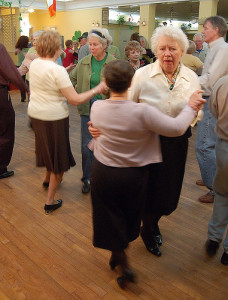Colette Glynn recalls one of the first times someone asked her onto the floor as an Irish jive dance partner, when she was 14 or 15 years old.
It wasn’t good.
“He said, ‘You’re useless,’ and he left me,” Glynn laughs. “I swore at that moment that no one would ever call me ‘useless’ again, and I would learn how to jive.”
If you haven’t heard of Irish jive, don’t think Riverdance. Think more like—but not exactly— Texas two-step.
“It’s a two-person dance,” Glynn explains, “and it’s kind of like swing dancing, but your feet never leave the ground. It’s pretty fast. There’s a lot of turning, and you’re pretty much moving all the time. Essentially it’s a man and a woman, or sometimes two women, and there is always a leader. That one is the one who is making the woman do all the turning and the fancy parts. The leader is kind of telling the woman what to do, and it’s the woman doing all the work.”
This Friday (July 19) Glynn is going to prove to anyone who cares to know that she long ago ditched the “useless” reputation. She’ll be teaching Irish jive in a workshop at the Philadelphia Irish Center/Commodore Barry Club in Mount Airy. Class starts at 7:30, and the cost is just $15.
Glynn, of Pompton Plains, N.J., came to Irish jive with a traditional Irish dance background, and with her parents’ encouragement, she went to had been going to Irish jiving socials, but she obviously didn’t take to it right away. After that less than flattering assessment of her jiving skills, Glenn embarked upon an unorthodox course of self-teaching.
“I tied a rope to a door handle, and I practiced turning to the beat. I did this on and off for about four months.” She had more to learn, of course—a living, breathing partner being a more complete experience than anything you might gain with a rope and a door handle. But there was no question she had improved greatly, as that previous partner conceded, with some degree of astonishment, the next time he and she took to the floor.
“He said, ‘Whoa, what happened?’ I’m now one of the only jiving teachers out there. I’ve been jiving for 30 years. Any time I see him now, he says, ‘I hope I get recognition for this.'”
So what kind of music lends itself to Irish jive? Surprisingly, perhaps, American country music works very well. Glynn’s brother decided he wanted Irish jive as the first dance at his wedding reception. Glynn taught the members of the wedding party. “You can use some traditional Irish music, but jive is about songs and words, not tunes. For the wedding, we chose Randy Travis’s ‘I’m Going to Love You Forever and Ever.'”
Though it might sound like a relatively new twist on Irish music and dance, jive has actually been around for a while. “It came from the old days in Ireland,” Glynn says.
Older jive dancers would recall strutting their stiff to tunes like “Four Country Roads,” performed by a band called Big Tom and the Travelers.
“You mention Big Tom to the older generation, like my parents and grandparents, and their eyes light up, because they know who he is.”
You can learn some of the basic steps, and maybe your eyes will light up, too.
If you’re going to the workshop, Glynn says, wear shoes with leather soles. “You need to be able to glide. Sneakers don’t have any ‘give’.”
Lessons will take place in the ballroom. There’s an Irish music concert in the front of the building the same night, so use the ballroom entrance. For more information contact John Shields at johngshields@comcast.net.

